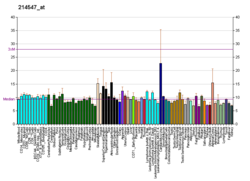From Wikipedia, the free encyclopedia
Protein-coding gene in the species Homo sapiens
ADCY10 Available structures PDB Ortholog search: PDBe RCSB List of PDB id codes 4CLK , 4CLL , 4CLP , 4CLS , 4CLT , 4CLU , 4CLW , 4CLY , 4CLZ , 4CM0 , 4CM2 , 4OYA , 4OYB , 4OYI , 4OYM , 4OYO , 4OYP , 4OYW , 4OYX , 4OYZ , 4OZ2 , 4OZ3 , 4UST , 4USU , 4USV , 4USW , 5D0R
Identifiers Aliases ADCY10 External IDs OMIM : 605205 ; MGI : 2660854 ; HomoloGene : 10188 ; GeneCards : ADCY10 ; OMA :ADCY10 - orthologs Wikidata
Adenylyl cyclase 10 also known as ADCY10 is an enzyme that, in humans, is encoded by the ADCY10 gene .[ 5]
Function
The protein encoded by this gene belongs to a distinct class of mammalian adenylyl cyclase that is soluble and insensitive to G protein or forskolin regulation. It is localized in the cytoplasm and is thought to function as a general bicarbonate sensor throughout the body. It may also play an important role in the generation of cAMP in spermatozoa , implying possible roles in sperm maturation through the epididymis, capacitation, hypermotility, and/or the acrosome reaction.[ 6]
Clinical significance
Mutations in the ADCY10 gene are associated with an increased risk of adsorptive hypercalciuria .[ 5]
References
External links
Further reading
Hukovic N, Panetta R, Kumar U, et al. (1998). "The cytoplasmic tail of the human somatostatin receptor type 5 is crucial for interaction with adenylyl cyclase and in mediating desensitization and internalization" . J. Biol. Chem . 273 (33): 21416–22. doi :10.1074/jbc.273.33.21416 PMID 9694905 . Buck J, Sinclair ML, Schapal L, et al. (1999). "Cytosolic adenylyl cyclase defines a unique signaling molecule in mammals" . Proc. Natl. Acad. Sci. U.S.A . 96 (1): 79–84. Bibcode :1999PNAS...96...79B . doi :10.1073/pnas.96.1.79 PMC 15096 PMID 9874775 . Hayes JS, Lawler OA, Walsh MT, Kinsella BT (1999). "The prostacyclin receptor is isoprenylated. Isoprenylation is required for efficient receptor-effector coupling" . J. Biol. Chem . 274 (34): 23707–18. doi :10.1074/jbc.274.34.23707 PMID 10446129 . Sinclair ML, Wang XY, Mattia M, et al. (2000). "Specific expression of soluble adenylyl cyclase in male germ cells". Mol. Reprod. Dev . 56 (1): 6–11. doi :10.1002/(SICI)1098-2795(200005)56:1<6::AID-MRD2>3.0.CO;2-M . PMID 10737962 . S2CID 34539645 . Chen Y, Cann MJ, Litvin TN, et al. (2000). "Soluble adenylyl cyclase as an evolutionarily conserved bicarbonate sensor". Science . 289 (5479): 625–8. Bibcode :2000Sci...289..625C . doi :10.1126/science.289.5479.625 . PMID 10915626 . Jaiswal BS, Conti M (2001). "Identification and functional analysis of splice variants of the germ cell soluble adenylyl cyclase" . J. Biol. Chem . 276 (34): 31698–708. doi :10.1074/jbc.M011698200 PMID 11423534 . Reed BY, Gitomer WL, Heller HJ, et al. (2002). "Identification and characterization of a gene with base substitutions associated with the absorptive hypercalciuria phenotype and low spinal bone density" . J. Clin. Endocrinol. Metab . 87 (4): 1476–85. doi :10.1210/jc.87.4.1476 PMID 11932268 . Zippin JH, Chen Y, Nahirney P, et al. (2003). "Compartmentalization of bicarbonate-sensitive adenylyl cyclase in distinct signaling microdomains". FASEB J . 17 (1): 82–4. doi :10.1096/fj.02-0598fje . PMID 12475901 . S2CID 22099561 . {{cite journal }}: CS1 maint: unflagged free DOI (link )Strausberg RL, Feingold EA, Grouse LH, et al. (2003). "Generation and initial analysis of more than 15,000 full-length human and mouse cDNA sequences" . Proc. Natl. Acad. Sci. U.S.A . 99 (26): 16899–903. Bibcode :2002PNAS...9916899M . doi :10.1073/pnas.242603899 PMC 139241 PMID 12477932 . Litvin TN, Kamenetsky M, Zarifyan A, et al. (2003). "Kinetic properties of "soluble" adenylyl cyclase. Synergism between calcium and bicarbonate" . J. Biol. Chem . 278 (18): 15922–6. doi :10.1074/jbc.M212475200 PMID 12609998 . Jaiswal BS, Conti M (2003). "Calcium regulation of the soluble adenylyl cyclase expressed in mammalian spermatozoa" . Proc. Natl. Acad. Sci. U.S.A . 100 (19): 10676–81. Bibcode :2003PNAS..10010676J . doi :10.1073/pnas.1831008100 PMC 196863 PMID 12958208 . Marjanovic JA, Li Z, Stojanovic A, Du X (2006). "Stimulatory roles of nitric-oxide synthase 3 and guanylyl cyclase in platelet activation" . J. Biol. Chem . 280 (45): 37430–8. doi :10.1074/jbc.M506518200 PMID 16144836 . Schmid A, Sutto Z, Nlend MC, et al. (2007). "Soluble Adenylyl Cyclase Is Localized to Cilia and Contributes to Ciliary Beat Frequency Regulation via Production of cAMP" . J. Gen. Physiol . 130 (1): 99–109. doi :10.1085/jgp.200709784 . PMC 2154360 PMID 17591988 .
This article incorporates text from the United States National Library of Medicine , which is in the public domain .
Activity Regulation Classification Kinetics Types






